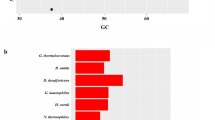Abstract
Pathogens Burkholderia pseudomallei (Bp) and Burkholderia mallei (Bm) contain a large number (> 12,000) of Simple Sequence Repeats (SSRs). To study the extent to which these features have contributed to the diversification of genes, we have conducted comparative studies with nineteen genomes of these bacteria. We found 210 genes with characteristic types of SSR variations. SSRs with nonamer repeat units were the most abundant, followed by hexamers and trimers. Amino acids with smaller and nonpolar R-groups are preferred to be encoded by the variant SSRs, perhaps due to their minimal impacts to protein functionality. A majority of these genes appears to code for surface or secreted proteins that may directly interact with the host factors during pathogenesis or other environmental factors. There also are others that encode diverse functions in the cytoplasm, and this protein variability may reflect an extensive involvement of phase variation in survival and adaptation of these pathogens.
Similar content being viewed by others
References
Benenson, A. (1995). Control of communicable diseases manual (Washington, DC, American Public Health Association).
Cheng, A.C., and Currie, B.J. (2005). Melioidosis: epidemiology, pathophysiology, and management. Clin. Microbiol. Rev. 18, 383–416.
Dance, D. (2000). Ecology of Burkholderia pseudomallei and the interactions between environmental Burkholderia spp. and human-animal hosts. Acta Trop. 74, 159–168.
Dharakul, T., and Songsivilai, S. (1999). The many facets of melioidosis. Trends Microbiol. 7, 138–140.
Godoy, D., Randle, G., Simpson, A., Aanensen, D., Pitt, T., Kino-shita, R., and Spratt, B. (2003). Multilocus sequence typing and evolutionary relationships among the causative agents of Melioidosis and Glanders, Burkholderia pseudomallei and Burkholderia mallei. J. Clin. Microbiol. 41, 2068–2079.
Holden, M.T.G., Titball, R.W., Peacock, S.J., Cerdeño-Tárraga, A.M., Atkins, T., Crossman, L.C., Pitt, T., Churcher, C., Mungall, K., Bentley, S.D., et al. (2004). Genomic plasticity of the causative agent of melioidosis, Burkholderia pseudomallei. Proc. Natl. Acad. Sci. USA 101, 14240–14245.
Levinson, G., and Gutman, G.A. (1987). Slipped-strand mispairing: a major mechanism for DNA sequence evolution. Mol. Biol. Evol. 4, 203–221.
Lin, C.H., Bourque, G., and Tan, P. (2008). A comparative synteny map of Burkholderia species links large-scale genome rearrangements to fine-scale nucleotide variation in prokaryotes. Mol. Biol. Evol. 25, 549–558.
McGilvray, C. (1944). The transmission of glanders from horse to man. Can. J. Public Health 35, 268–275.
Nierman, W.C., DeShazer, D., Kim, H.S., Tettelin, H., Nelson, K.E., Feldblyum, T., Ulrich, R.L., Ronning, CM., Brinkac, L.M., and Daugherty, S.C. (2004). Structural flexibility in the Burkholderia genome. Proc. Natl. Acad. Sci. USA 101, 14246–14251.
Romero, C., DeShazer, D., Feldblyum, T., Ravel, J., Woods, D., Kim, H.S., Yu, Y., Ronning, C., and Nierman, W. (2006). Genome sequence alterations detected upon passage of Burkholderia malle ATCC 23344 in culture and in mammalian hosts. BMC Genomics 7, 228.
Salaun, L, Snyder, L.A.S., and Saunders, N.J. (2003). Adaptation by phase variation in pathogenic bacteria. Adv. Appl. Microbiol. 52, 263–301.
van Belkum, A., Scherer, S., van Alphen, L, and Verbrugh, H. (1998). Short-sequence DNA repeats in prokaryotic genomes. MMBR 62, 275–293.
van der Woude, M.W., and Baumler, A.J. (2004). Phase and antigenic variation in bacteria. Clin. Microbiol. Rev. 17, 581–611.
Waag, D.M., and DeShazer, D. (2004). Glanders: New Insights into an Old Disease (New Jersey: Humana Press).
Author information
Authors and Affiliations
Corresponding author
About this article
Cite this article
Song, H., Hwang, J., Myung, J. et al. Simple sequence repeat (SSR)-based gene diversity in Burkholderia pseudomallei and Burkholderia mallei . Mol Cells 27, 237–241 (2009). https://doi.org/10.1007/s10059-009-0029-8
Received:
Accepted:
Published:
Issue Date:
DOI: https://doi.org/10.1007/s10059-009-0029-8




